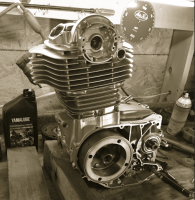jag767
Over 1,000 Posts
teazer said:Now it is getting really interesting. Lots of pictures please...
Absolutely! I plan on getting all the info from Tom that I can while I am there. He know's things about these motors that really is quite fantastic. I mentioned how this now has me wanting a 450 desmo, to which he laughed. Apparently the holy grail status of a desmo head is greatly misunderstood. Either way, as info on these engines is not the easiest to come by, i'll be taking notes ;D.
I took the top end apart last night, and damn that was easy. I'm used to fighting with a mess of JIS screws that want to strip, 4 pistons worth of moving parts, and a cam chain. Nope! 4 bolts and yank! Not even 1 stuck gasket. Oh, and no head gasket! The way the head is machined there's no need for one, it's nuts!
I gotta say, after inspecting the internals first hand, I'll like to see these motors re engineered slightly with today's knowledge, and put back into production. There are a few things I even noticed immediately such as the shape of the valves that could easily be improved. I see no reason why a nice reliable 500cc example couldn't be a real gem back in the ducati line up. So Damn pretty too! Anyhow I digress. I'll have a major update after Tom's today.





